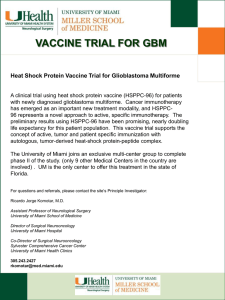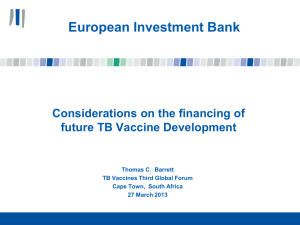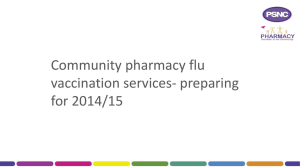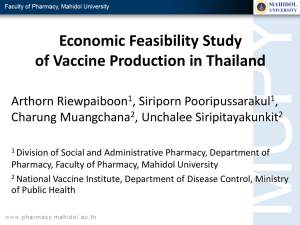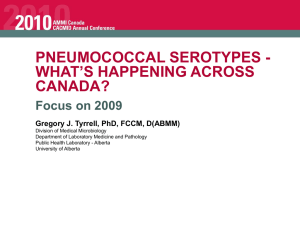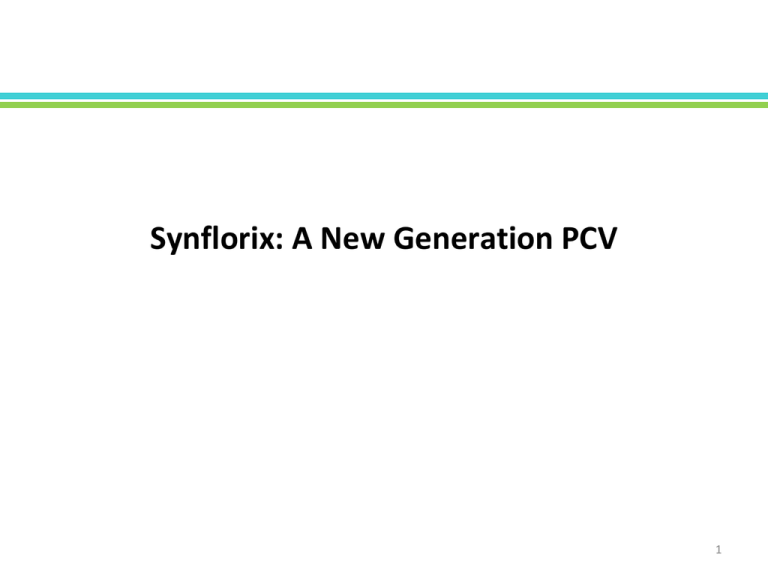
Synflorix: A New Generation PCV
1
Pneumococcal Serotypes Surveillance so far
• 6 studies in children less than 5 years
• All the isolates were from normally sterile sites
2
STP
IBIS
(1999)
n=101
14
SAPNA
(2007)
(22)
23F
03
1
14
Bangladesh
1992-2007
(2008)
PneumoADIP
ASIA 2009
Sri lanka
Nepal
n=4
n=26
N=56
n=18
n=137
n=71
n=162
n=4752, %
03
01
02
09
02
15
11.6%
04
01
-
01
6
PNEUMONET
India
08
6B
ANSORP
(2008)
05
01
19F
04
11.5%
(08)
(08)
(08)
02
00
04
02
00
9.7%
14
02
16
5
11
9.5%
01
01
09
03
8.1%
19
(11)
5
05
9V
(01)
18C
(03)
01
01
05
01
NA
2.4%
7F
04
02
-
08
03
16
2%
4
06
06
05
01
-
01
6A
3/91
01
1.6%
04
00
NA
05
3
01
24
02
09
02
24
00
6.7%
3.1%
-
19A
0thers
08
2.6%
3.5%
-
-
-
1.4%
3
26.4%
Asian Network for Surveillance of Resistant
Pathogens (ANSORP): 2008-2009
• Study was conducted in 10 South Asian countries
• Total 91 isolates of 19A were collected to see resistance
patterns
• India had contributed 3 isolates of 19A during this period
– Under 5 or more than 5 years is not known or clear
– It was retrospective or prospective study and case definition is not
defined? As purpose was to see resistance
• Most of the isolates were collected from Sputum etc and
hence Non-invasive
• J Antimicrob Chemother Feb 2011; Shin et al
4
ALLIANCE FOR SURVEILLANCE OF INVASIVE
PNEUMOCOCCI (ASIP) IN INDIA
‘When you've got something to prove, there's nothing
greater than a challenge.’ -- Terry Bradshaw
12
JAN to NOV 2011 – Key
developments
Identification of sentinel Drs /
Pvt Lab for developing sentinel
network in Mumbai , Delhi ,
Bangalore , Chennai
JAN
CRC
Recruitment for
Chennai ,
Bangalore ,
Delhi
FEB
Serotyping and AST work
initiated. Consolidation of study
data, presentation at 3rd IM
MARCH
Sentinel network initiated
in Kolkata , Coimbatore ,
Hyderabad , Ahmedabad
AUG
Pneumo season
- Isolation +
serotyping
SEPT OCT – DEC’11
IM Meeting in
GOA
Sept 2011
ASIP – Year 2
ZONAL
CONSOLIDATION
DEC – JAN ‘12
PEDICON
ASIP POSTER
ASIP website launched
e -CRF developed
16
February 2011 – ASIP website
launched
http://www.asipindia.org
17
Study Centres
Sr.
No.
Institutional
Network
1 MGIMS, Wardha
2 SRMC, Chennai
3 AIMS, Cochin
4 KEM, Mumbai
Safdarjung Hospital,
5 Delhi
6 CNBC, Delhi
7 St. John, Bangalore
8 CMC, Ludhiana
9 BVP, Pune
Study Central
Monitoring
Laboratory,
CMC, Vellore
10 KEM, Pune
11 LTMMC, Mumbai
12 Pushpagiri, Tiruvalla
19
Ahmedabad
ASIP Sentinel Network
Dr P.K. Assudani
Dr Sandip Trivedi
Delhi
Dr. Pratima Shah
Dr. Amarjeet Chitkara
Dr. Raju Shah
Dr. P.S. Narang
Dr Azad H Jain
Dr. Mukesh Agarwal
Dr. Deepika Jain
Dr Shyam Kukreja
Dr Atul M Nayak
Dr. Devender Gaba
Dr K.P. Shah
Dr.Bharat Patel
Dr. Vinod V Patel
Dr. Mahesh Barot
Dr Rajiv Bhatla
Dr Naveen Thacker
Kolkata
Dr Jogesh Sachde
Dr Jaydeep Choudhury
Dr Nitin Thakkar
Dr. Rajen Bit
Dr Nehal Vaidya
Dr. Arunaloke Bhattacharya
Pune
Mumbai
Dr. Ambrish Mishra
Dr. Y.K. Amdekar
Dr. Rushikesh Damle
Dr. Mangalmurti Bhalerao
Dr. Vijay N. Yewale
Dr. Mahesh A.Mohite
Dr. Indu Khosla
Dr. Praful R. Shanbhag
Coimbatore
Dr K Neminathan
Bangalore
Dr. Jagdish Chinnappa
Dr. Srinivas G Kasi
Dr. A. Nagesh
Dr. R. Kishore Kumar
Dr. Achamma Thomas
Dr Mallika Neminathan
Dr. Ishwarya
Dr. Poornima
Dr. Arunthathy
Anantapur- AP
Dr Gerardo
Cochin
Chennai
Dr. Grace Thomas
Dr S Balasubramaniam
Dr. Suja Mathew
Dr V V Varadarajan
Dr. Varghese Cherian
Dr Raghu
20
ASIP LOCAL LAB
Sl.
No. Local Labs
1 Dr Neeraj Jain, Delhi
Dr Shrikrishna. A.
2 Joshi, Mumbai
Dr.Anuradha Manoj,
3 Kolkata
Dr Brahmadathan,
4 Coimbatore
Dr Sangeetha Joshi,
5 Bangalore
Dr.
Manisha
6 Shekhar, Ahmedabad
Dr Urvesh U Shah,
7 Ahmedabad
21
Update on Recruitment and +ve Cultures
(as on 23rd Nov 2011)
Institution
Total
recruitments
Prospective/ Retrospective
S.pn
H. inf
MGIMS, Wardha
190
-
-
SRMC, Chennai
36
-
-
AIMS, Cochin
40
1
-
KEM, Mumbai
26
4
-
Safdurjung Hosp, Delhi
14
14
-
CNBC, Delhi
38
-
-
St. John, Bangalore
70
3
-
CMC, Ludhiana
6
2
1
BVP, Pune
14
4
-
KEM, Pune
42
2
-
LTMMC, Mumbai
10
4
-
Pushpagiri, Tiruvalla
68
2
-
All regions
275
5
Total
829
41
Sentinel Network
1
23
ASIP: Distribution of Serogroup/type
Preliminary Results (n=35 out of 42), 2011
Serogroup / Serotype
No. isolated
1
01
4
01
5
02
10
04
7F
-
9V
-
14
01
18C
-
19F
03
23F
02
3
-
6
03
19A
01
Others
17
19 A % : 1/35 ( 2.85 %)
19F % : 3/35 ( 8.57%)
-----------------------------------19 % : 4/35 (11.4%)
• In line with previous studies and
PneumoADIP- Asia: 2009
Data on file: www.asipindia.org
12
Pneumonia kills 45 children
an hour
…1095 children a day
…7,692 children
a week
…33,300 children
a month
Hib
Pneumo
DRAFT
Each year pneumonia kills
over 400,000 children in
India
~50,000 by Hib
~142,000 by pneumococcus
Serotype 3
Serotype 3 is an atypical serotype1,2
Serotype 3 pneumococci are abundantly capsulated, making the
bacteria less sensitive to immune interactions1
Polysaccharide capsule 2
Serotype 3
Serotype 19F
Serotype 3 probably behaves differently in vivo (biofilms) 3
Has tendency to switch off the capsule or express it in an abundant way
1.Poolman J, et al. Vaccine 2009;27: 3213-3222
2.Hammerschmidt et al. Infection and Immunity 2005;73(8):4653-67
3. Waite RD, Struthers JK, Dowson CG. Mol Microbiol 2001;42(5):1223-32
Serotype 3 displays an atypical immunogenicity
profile
11-valent Pn-PD in POET
13-valent-CRM
100
11Pn-PD post-primary
90
11Pn-PD post-booster
Patients (%)
80
HAV post-primary
70
HAV post-booster
60
PCV 10 vs PCV 13? Or PCV 12
50
40
Kieninger et al.,ICAAC 2008
(http://uploads.renegadedigital.com/Istanbul/
kieninger.pdf;)
30
20
10
•
0
0.1
1.0
10.0
100.0
Antibody concentration (µg/mL)
Serotype 3 ELISA immunogenicity: higher responses post-primary than postbooster
Adapted from Prymula et al. Lancet 2006;367:740–748
Do 6B conjugates provide cross
protection against 6A disease?
IPD cases per 100,000
6
Pre-PCV7
5
4
4
Post-PCV7
Synflorix anti-6A functional activity
(OPA) appears similar to PCV7CRM
100
80
PCV 10 vs PCV 13?60Or PCV 11
3.3
3
2.1
1.9
2
1.1
1
4.9
Serotype 6A OPA, % >8
Decreases in 6A IPD after PCV7CRM introduction
1.6
1
0.8
1.1
0.4
0.46
0
40
20
0
DiT-001/007 DiT-011/017 DiT-036
DiT-012/018 DiT-012/018
2-3-4 mo
2-4-6 mo
2-4-6 mo
6-10-14 wks 2-4-6 mo
& 12>18 mo & 11>18 mo & 11>18 mo & 12>18 mo & 12>18 mo
DTPa-combo
Belgium and Denmark 2+1 UMV since 2007; England and Norway: 2+1 UMV
since 2006; Australia: 3+0 UMV since 2005; US: 3+1 UMV since 2000
4. Hanquet et al. Vaccine 2011;29:2856-2864; 5. Harboe et al. Vaccine 2010;28:2642-2647; 6. Foster
et al. Int J Med Microbiol 2011;60:91-97; 7. Vestrheim et al. Vaccine 2010;28:2214-2221; 8. Williams
et al. Med J Australia 2011;194:116-120; 9. Pilishvili et al. J Infect Dis 2010;201:32-41; 10. Park J
Infect Dis 2008;198:1818-22
DTPw-combo
PCV7 Post-primary
Synflorix Post-primary
PCV7 Post-booster
Synflorix Post-booster
Schuerman, et al. ISPPD-7 Tel Aviv, 14–18 March 2010 (Abstract 475) ;
Vaccine efficacy or
effectiveness against 19A
Vaccine efficacy or effectiveness against 19A
invasive disease
IPD
SYN-2010-051
AOM
80
60
40
20
0
-20
-40
-60
1
2
3
4
5
6
7
-80
1.
2.
3.
4.
5.
6.
7.
14 v PS: US indirect cohort analysis (1993) (with 19F but not 19A)1
7vCRM: US post-marketing surveillance (assessment 2nd year after launch)2
7vCRM: US CDC case-control3
7vCRM & 9vCRM: meta-analysis of 4 efficacy studies in US, Gambia, South Africa4
7vCRM: Quebec post-marketing surveillance5
7vCRM: Finland: FinOM6
7vOMP: Finland: FinOM6
Every time it has been examined, the efficacy/effectiveness point
estimate against 19A has been positive
PCV7-CRM: Prevenar™/Prevnar™ is a trademark of Pfizer/Wyeth
Adapted from Hausdorff et al BMC 2010
1. Butler 1995; 2. Whitney NEJM 2003; Whitney Lancet 2006; 4. Klugman 2008; 5. Deceunick ESPID 2009; 6. Eskola NEJM 2001
Synflorix elicits higher functional activity (OPA)
against vaccine-related serotype 19A than PCV7
Serotype 19A OPA, % ≥8
100
80
60
40
20
0
DiT-001/007
DiT-011/017
DiT-036
DiT-012/018
DiT-012/018
2-3-4 mo
& 12>18 mo
2-4-6 mo
& 11>18 mo
2-4-6 mo
& 11>18 mo
6-10-14 wks
& 12>18 mo
2-4-6 mo
& 12>18 mo
DTPa-combo
PCV7 Post-primary
PCV7 Post-booster
DTPw-combo
Synflorix Post-primary
Synflorix Post-booster
18
Schuerman, et al. ISPPD-7 Tel Aviv,14–18 March 2010 (Abstract 475)
Pneumococcal 19F polysaccharide conjugation to
the carrier proteins
Native 19F structure
PCV 10 vs PCV 13? Or PCV 10 ½
Reductive amination
Cyalinilation
Different conjugation chemistries used for the two vaccines
SYN-2010-051
19F structure in Pfizer vaccines
19F structure in Synflorix™
Kim et al. Anal . Biochemistry 2005
Cross-sectional surveys in South India
Prevalence and sequelae of otitis
media
Acute suppurative otitis media: 1.5%
Otitis Media with Effusion: 6%
Chronic suppurative otitis media: 1.4%
Eustachian tubal block: 4%
Prevalence rate of CSOM was found
to be 6% in children 2-10 yrs
20
S. pneumoniae and H. influenzae account for up to 80%
of bacterial AOM cases in children16
Australia Post-PCV7 08-09 (15)
Thailand 07-08 (14)
Japan 03 (8)
US Post-PCV7 006-08 (13)
US Post-PCV7 00-03 (9)
US pre-PCV7 92-98 (9)
Spn
Columbia 08 (12)
Spn + Hi
Mexico 08 (11)
Hi
Costa Rica 02-07 (10)
Mcat
Costa Rica 99-04 (7)
S. pyog
Chile (6)
Others
Spain 89-95 (5)
Czech & Slovak 00-02 (4)
France 87-97 (3)
Finland (2)
Israel 00-01 (1)
0%
10%
20%
30%
40%
50%
60%
% of culture confirmed cases
70%
80%
90%
100%
AOM caused by S. pneumoniae and H. influenzae are clinically indistinguishable
(Liebowitz PIDJ 2004)
1. Broides et al., Clinl Infects Dis 2009;49:1641–7; 2. Eskola J, et al. N Engl J Med 2001;344:4039; 3. Gehanno P, et al. Pediatr Infect Dis J 2001;20:5703; 4.Prymula R, et al. Lancet 2006;367:7408; 5. Del Catillo
F, et al. Pediatr Infect Dis J 1996;15:5413; 6.Rosenblut A, et al. Pediatr Infect Dis J 2001;20:5017; 7. Guevara et al., Pediatr Infect Dis J 2008;27: 12–6; 8. Suzuki A, et al. Pediatr Infect Dis J 2005;24:6557; 9.Block
21
SL, et al. Pediatr Infect Dis J 2004;23:8293; 10. Aguilar et al Int J Pediatr ORL. 2009; 73:1407-11; 11. Parra M et al., WSPID Buenos Aires, Nov 2009 (Abstract 797); 12. Sierra A et al., 14th ICID, Miami Mar 2009
(abstract 1129); 13. Casey & Pichichero Pediatr Infect Dis J 2010; 29(4):304-9; 14. Intakorn P et al. ISRAOM Seoul, Korea, 2009; 15. Kirkham, et al. ISPPD-7 2010 Tel Aviv, (Abstract 448); 16. Grevers et al. Int J
NTHi in lower respiratory tract disease
Bronchoalveolar lavage studies (non-CF patients)
Country
Author, Reference,
Year
Cases
% NTHi
France
Le Bourgeois, Chest, 2002
Recurrent wheezing
50%
US
Saito, Ped Pulm, 2006
Recurrent wheezing
26%
Spain
Romero, ERS, 2009
Persistent bacterial bronchitis
28%
Belgium
De Schutter, ESPID, 2009
Refractory bronchopneumonia,
Recurrent bronchopneumonia,
Persistent X-ray abnormalities
Persistent wheezing
43%
UK
Marguet, Am J Resp, 1999
Chronic cough
43%
Davidson, ERS, 2010
Persistent respiratory symptoms
30%
Australia
Hare, J Ped, 2010
Bronchiectasis
47%
Greece
Mammas, ERS, 2010
Protracted purulent bronchitis
61%
In contrast, likely minor role for NTHi in consolidated alveolar pneumonias
22
GSK Internal literature review, M. Van dyke; Hausdorff & Dagan Vaccine 2008
Can a protein D conjugate vaccine prevent acute otitis media
RANDOMISATION 1:1
by NTHi? Pneumococcal Otitis Efficacy Trial (POET)
11-PN-PD (NATP = 2455)
+ Infarix Hexa in both groups
24–27 months follow-up
Havrix (NATP = 2452)
Dose 1
Dose 2
Dose 3
Booster
±3 months
±4 months
±5 months
±15–18
months
DTPa-HBV-IPV/Hib: Infanrix hexa™ and HAV: Havrix™ are trademarks of the GlaxoSmithKline group of companies
.
Key endpoints:
1. AOM due to
Vaccine types
Any
pneumococcus
Adapted from Prymula, et al. Lancet 2006; 367: 740–48
NTHi
2. Nasopharyngeal carriage
due to pneumococcus
and NTHi
AOM Efficacy Trial Results
Acute Otitis Media Endpoint
Any (confirmed by presence of middle-ear
fluid)
Vaccine pneumococcal serotypes
Non-vaccine pneumococcal serotype
Haemophilus influenzae
Recurrent AOM
Vaccine Efficacy
(95% CI)
POET [11Pn-PD]
Vaccine Efficacy
(95% CI)
FinOM [PCV-7]
% 33.6
%6
(20.8 to 44.3)
(-4 to16)
% 57
% 57
(41.4 to 69.3)
(44 to 67)
%8
% -33
(-64.2 to 49)
(-80 to 1)
% 35.6*
(-%11)
(3.8 - 57.0)
(-34 to 8)
% 55
% 16
(-1.9 to 80.7)
(-6 to 35)
*Non-Typeable Haemophilus influenzae % 35.3 (1.8 to 57.4)
Note: Results cannot be quantitatively compared due to differences in study population,
epidemiology of AOM, case-ascertainment , etc.
1.Eskola J, et al. N Engl J Med 2001; 344:403-409; FinOM: Finnish Otitis Media; 2. Prymula R, et al. Lancet 2006; 367:740–748
24
PCV 10 vs PCV 10 ½ ?
Or
2 (pathogens) vs 1 (pathogen)
Synflorix has undergone an extensive
clinical development programme
30 clinical studies completed by August 2011
6,730 infants; 5,098 toddlers; ~26,000 doses of PHiD-CV administered
Immunogenicity profile documented
Multiple immunization schedules1–14
for 10 vaccine serotypes, cross-reactive
serotypes 6A and 19A, and
protein D1–5,7–12
Vaccine interchangeability at booster age1
Six studies included PCV-7 as control1–5
Co-administration with routine
paediatric vaccines1–14
Immunological non-inferiority demonstrated
versus PCV-71–5
Safety and tolerability profile similar to
PCV-74,6,7
Catch-up schedules in older children not
primed at younger age15
DTPa-IPV/Hib, DTPa-HBV-IPV, DTPa-HBVIPV/Hib, DTPw-HBV/Hib (Tritanrix-HepB or
Zilbrix), OPV, IPV, MenC-CRM197, MenC-TT, HibMenC, Hiberix, HRV, MMRV and Pediacel
1. Vesikari T, et al. Pediatr Infect Dis J 2009; 28: S66–S76; 2. Wysocki J, et al. Pediatr Infect Dis J 2009; 28: S77–S88; 3. Bermal N, et al. Pediatr
Infect Dis J 2009; 28: S89–S96; 4. Knuf M, et al. Pediatr Infect Dis J 2009; 28: S97–S108; 5. Kim CH, et al. ISPPD-7 Tel Aviv, 2010 (Abstract 472); 6.
Kim CH, et al. ISPPD-7 Tel Aviv, 2010 (Abstract 159); 7. Chevallier B, et al. Pediatr Infect Dis J 2009; 28: S109–S118; 8. van den Bergh MR, et al.
28th ESPID, Nice, June 2010 (Abstract 1163); 9. Lagos R, et al. ISPPD-6 Reykjavik, 8–12 June 2008 (Abstract 486); 10. Vesikari T et al. ISPPD-7
Tel Aviv, 2010 (Abstract 474); 11. Prymula R, et al. Lancet 2009; 374: 1339–50; 12. Silfverdal SA, et al. Pediatr Infect Dis J 2009; 28: e276–e82; 13.
Omenaca F, et al. ESPID 2009; Nice, France, abstract 505; 14. Omenaca F, et al. WSPID 2009; Buenos Aires, Argentina; abstract 51;
15. ClinicalTrials.gov http://clinicaltrials.gov/ct2/show/NCT00345358 [accessed 31 Jan 2011].
PHiD-CV effectiveness against
pneumonia – Brazil
•
PHiD-CV was introduced into the Brazilian National Immunization Programme
in 2010
•
A case-control study evaluating a randomly selected cohort of 1,284 children
7–18 months of age was conducted to determine the effectiveness of PHiD-CV
against community-acquired pneumonia (CAP)*
Approximately 1 year after the
introduction of routine PHiD-CV
vaccination, vaccine effectiveness
against CAP was
40% (95% CI 1.4, 63.0)
*PHiD-CV is not currently indicated for the prevention of pneumococcal pneumonia in Brazil.
Andrade A, et al. WSPID 2011, Melbourne, Australia, Abstract 670.
PHiD-CV effectiveness against IPD
– Brazil
•
Recent surveillance data from Brazil has shown that PHiD-CV has
reduced the incidence of meningitis
1400
Cumulative number in children <2 years of age,
by month of occurrence, 2007-10
Cumulative number in all ages,
by month of occurrence, 2007-10
2007
2008
2009
2010
400
2011
350
300
1000
Cumulative cases
Cumulative cases
1200
800
600
400
2007
2010
2011
250
200
~48% reduction
any
pneumococcal
meningitis
Jun11 vs. Jun10
150
50
0
2009
PHiD-CV introduced
March-June 2010.
UMV, 3+1 schedule
100
200
2008
0
Jan Feb Mar Apr May Jun Jul Aug Sep Oct Nov Dec
Jan Feb Mar Apr May Jun Jul Aug Sep Oct Nov Dec
Month
Month
Brazil National Pneumococcal meningitis reporting. MoH - SAUDE :
http://portal.saude.gov.br/portal/saude/profissional/visualizar_texto.cfm?idtxt=37811 accessed 21 Nov 2011
Dr. Shailesh MEHTA
Clinical R & D and Medical affairs, South Asia
COMPAS design summary
• COMPAS is the most comprehensive Synflorix study to
date and was designed to:
– Assess the public health value of Synflorix
– Confirm and quantify impact of Synflorix against pneumonia
– Assess the impact of Synflorix against acute otitis media
Sáez-Llorens X, et al. ESPID 2011, The Hague, The Netherlands, Abstract 1412
Clinical Otitis Media and
Pneumonia Study (COMPAS)
• Multicentre, doubleblind, randomised,
controlled trial
• Sample Size = 24,000
• Synflorix™ vs. control
(Randomised 1:1)
• 3 Latin American
countries
• Urban Setting
• Good access to health
care system
Panama:
7 centres
N= 7.000
subjects
Colombia:
3 centres
N= 3.000
subjects
Argentina:
17 centres
N=14.000
subjects
Randomisation 1:1
Study design relative to CAP surveillance
Age (Months)
Double Blind randomized Controlled Multi center study in
Argentina (3), Colombia, Panama
All subjects received vaccines within
the routine immunization program
with in addition:
SynflorixTM Group
+ DTPa-IPV/Hib
Panama: opportunity for ALL
subjects to receive Varilrix™
Control Group
N=~12,000
Argentina: opportunity for ALL
subjects to receive MenC-CV
(HBV) + DTPa-IPV/Hib
(HAV) + DTPa-IPV/Hib
+ DTPa-HBV-IPV/Hib
~2
~4
~6
N=~12,000
Colombia: opportunity for ALL
subjects to receive HRV
15-18
Vaccine
3-Dose primary
CAP
Booster
Suspected CAP (X-ray request)
Independent Data
Monitoring Committee
(IDMC) of experts
overviewed ethical, safety
aspects
Synflorix™, PHiD-CV; DTPa-HBV-IPV/Hib: Infanrix™ hexa; DTPa-IPV/Hib: Infanrix™ penta; HAV, Havrix™ ; Varilrix™, Varicella vaccine,
are trademarks of the GlaxoSmithKline group of companies.
MenC-CV : licensed meningococcal serogroup C conjugate vaccine
1. Tregnaghi et al., XIV SLIPE, May 2011; 2.Tregnaghi et al., 29th ESPID, June 2011;
3 . Saez-Llorenz et al., 29th ESPID, June 2011; 4. 10PN-PD-DIT-028; NCT00466947
CAP definitions in COMPAS
Case definition
X-ray request
X-ray
readers panel
Alveolar
consolidation
Non-consolidation
No pneumonia
Non-interpretable
Lab results
CRP value g/mL
Clinical suspicion of
CAP or child with ARI
Any
on
Any abnormality
abnormality on
chest x-ray
chest
x-ray
(CXR-CAP)
(CXR-CAP)
Non-consolidated
(CXR-NAC-CAP)
Suspected
Suspected CAP
CAP
(S-CAP)
Normal
(no pneumonia) or
non-interpretable
Consolidated
Consolidated
(CXR-AC-CAP)
Primary endpoint
endpoint
Primary
likely bacterial
bacterial CAP
likely
CAP
(B-CAP)
CXR-NAC-CAP
with CRP
< 40 g/mL
Sáez-Llorens X. et al. ESPID 2011; The Hague, The Netherlands. abstract 1412
CXR-NAC-CAP
with
CRP
with CRP
≥ 40 g/mL
COMPAS timeline
2007
2008
Enrolment
2009
2010
2011
2012
Jun 2007 – Dec 2008
Observation
period
Observation
period
Interim analysis
B-CAP
Nov 2010 – Jan 2011
≥ 535 B-CAP ATP cases
Conclusive
Initiate final analysis
End-of-study
results
Spring 2012
Pneumonia aetiology is difficult to establish
and can be caused by both viruses and bacteria1
Aetiology of pneumonia in 99 hospitalised children <5 years old
in Switzerland2
Unknown
14%
Bacterial only (single
or multiple bacteria)
19%
Samples from blood
culture and
nasopharyngeal
aspirates
Mixed
viral/bacterial
infection
33%
Viral only (single or
multiple)
34%
– Limitations of microbiological diagnostic methods make exact
aetiology difficult to establish3
– Viral pneumonia may suppress immune responses, and result in
bacterial pneumonia super-infections4
1. UNICEF, 2006. Pneumonia: the forgotten killer of children; 2. Cevey-Macherel et al. Eur J Pediatr 2009;
168: 1429–36; 3. Brown. Respirology 2009;14:1068–71; 4. Warr & Jakab. Inflammation 1983; 7: 93–104
Primary objective is met. Efficacy for other CAP
endpoints (first episodes) also observed
Synflorix™
Vaccine efficacy (%)
[95% CIs] , p-value
B-CAP
Likely Bacterial CAP
Crx-CAP + NCrx-CAP & CRP ≥ 40 µg/ml
C-CAP
Alveolar consolidation on Chest X-ray analyzed
acc to WHO definition
CxrC-CAP
Confirmed CAP
by any abnormality on Chest X-ray
S-CAP
All Suspected clinical CAP
Per-protocol (ATP)
Intent-to-treat (TVC)
22.0 [7.7;34.2]
18.2 [5.5;29.1]
p=0.0020^
p=0.0031
25.7 [8.4;39.6]
23.4 [8.8;35.7]
13.3 [3.4;22.1]
10.5 [1.8;18.4]
6.7 [0.7;12.3]
7.3 [2.1;12.3]
^ p-value significant if lower than 0.0175
*first episodes of pneumonia by Data Lock Point 31Aug2010
Per-protocol : Vaccine Efficacy for time to first occurrence of CAP anytime from 2 weeks after the administration of dose III and part of the ATP cohort.
Intent-to-treat: Vaccine Efficacy for time to first occurrence of likely bacterial CAP (B-CAP) anytime from the administration of dose I
1.Tregnaghi et al., XIV SLIPE, Punta Cana, May 2011; 2.Tregnaghi et al., 29th ESPID, The Hague, June 2011
3.10PN-PD-DIT-028; NCT00466947
COMPAS – efficacy of Synflorix™ against Pneumonia
(First Episodes)
Endpoint for ITT cohort
Efficacy %
B-CAP
18.2%
(95% CI)
Likely Bacterial CAP
Crx-CAP + NCrx-CAP & CRP ≥ 40 µg/ml
[5.5;29.1]
C-CAP
23.4%
Alveolar consolidation on Chest X-ray
analyzed acc to WHO definition
CrxC-CAP
[8.8;35.7]
10.5%
Confirmed CAP
by any abnormality on Chest X-ray
[1.8;18.4]
S-CAP
7.3%
All Suspected clinical CAP
[2.1;12.3]
Synflorix™ Control
N=11.875 N=11.863
# of cases/
averted
341
414
73
223
289
66
854
947
93
2455
2616
161
Intent-to-treat: Vaccine Efficacy for time to first occurrence of likely bacterial CAP (B-CAP) anytime from the administration of dose I
1. Tregnaghi et al., 29th ESPID, The Hague, June 2011; 2.10PN-PD-DIT-028; NCT00466947
PCV effectiveness against IPD –
Quebec
Quebec
•
PCVs have been used in Quebec since 2002
•
In 2009, PHiD-CV replaced PCV-7 in the infant
routine immunization programme
•
In 2010, PCV-13 was introduced in place of
PHiD-CV for universal mass vaccination
High-risk &
indigenous children
Universal mass vaccination programme
HIGH VACCINATION COVERAGE
3+1 schedule
(2, 4, 6 + 12 mo)
2002
2003
October 2002
PCV-7
(including catch up for
≤ 5 years of age)
(~97% of children vaccinated)
2+1 schedule (2, 4 + 12 months)
2004
2005
December 2004
PCV-7
(including catch up for
≤ 5 years of age)
2006
2007
2008
2009
2010
2011
June 2009
PHiD-CV
December 2010
PCV-13
(transition in July–August
2008, no catch-up)
(transition in January 2011,
no catch-up)
Institut national de santé publique du Québec, Programme de surveillance du Pneumocoque, RAPPORT 2009
http://209.171.32.187/gouvqc/communiques/GPQF/Decembre2010/10/c4447.html.
PCV effectiveness against IPD –
Quebec
•
A recent effectiveness study examined the rates of IPD in children immunised
with PCV-7 or PHiD-CV
p = 0.02
IPD rate/100,0000
person years
p < 0.05
70
60
50
40
30
20
10
0
60
42% reduction
56% reduction
50
40
30
64.1
54.0
20
37.1
23.9
10
0
Jun 2007-Jun 2008
Jun 2009-Jun 2010
Birth cohort (6–18 months)
Aug 2007-Jan 2008
Aug 2008-Jan 2009
Birth cohort (13–28 months)
Primary vaccine
PCV-7
PHiD-CV
PCV-7
PCV-7
Booster vaccine
PCV-7
PHiD-CV
PCV-7
PHiD-CV
• The results demonstrated the effectiveness of PHiD-CV at reducing the
number of IPD cases compared with PCV-7
• A significant reduction in IPD cases was also observed in children who
received PCV-7 as the primary series and PHiD-CV as the booster
De Wals P, et al. ESPID 2011; The Hague, The Netherlands. Abstract P763.
PCV effectiveness against IPD –
Quebec
Birth
cohort
Observation
Vaccine for
period
primary series
and booster
Aug 2007Jan 2008
13-28 mos
PCV-7
PCV-7
0
5
12
9
26
IPD
rate per
100 000
personyears
54.0
Aug 2008Jan 2009
13-28 mos
PCV-7
PHiD-CV
0
0
8
4
12
23.9
Jun 2007Jun 2008
6-18 mos
PCV-7
PCV-7
1
3
16
15
35
64.1
Jun 2009Jun 2010
6-18 mos
PHiD-CV
PHiD-CV
2
0
10
9
21
37.1
PCV-7
types
De Wals P, et al. ESPID 2011; The Hague, The Netherlands. Abstract P763.
IPD cases
Additional 19 A
PHiD-CV
types
Other
types
All
types
Thank you

